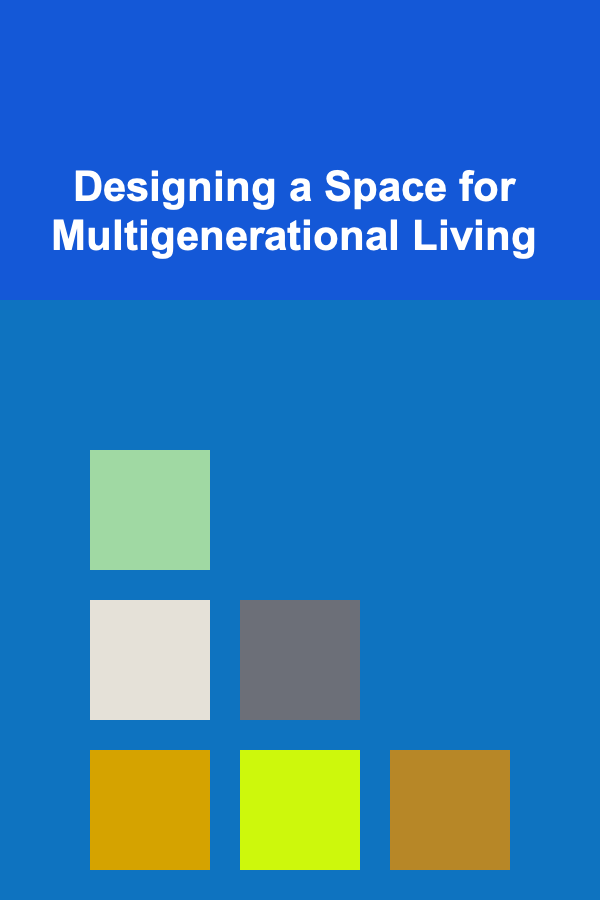
Designing a Space for Multigenerational Living
ebook include PDF & Audio bundle (Micro Guide)
$12.99$6.99
Limited Time Offer! Order within the next:

Multigenerational living, where two or more generations of a family reside under one roof, is experiencing a resurgence in popularity. Driven by factors such as economic pressures, aging populations, and a desire for stronger family bonds, this living arrangement presents unique challenges and opportunities in residential design. Creating a harmonious and functional space for multiple generations requires careful planning, thoughtful consideration of individual needs, and a commitment to fostering both connection and independence. This article explores the key principles and practical considerations involved in designing a space that effectively supports multigenerational living, addressing everything from initial planning to specific design elements that promote comfort, accessibility, and privacy for all residents.
Understanding the Needs and Challenges
Before embarking on the design process, it's crucial to thoroughly understand the needs, preferences, and potential challenges associated with each generation that will be living in the home. This involves open communication and a willingness to compromise to create a space that works for everyone. Ignoring these critical factors can lead to friction and ultimately undermine the success of the multigenerational living arrangement.
Identifying Individual Needs and Preferences
Each generation brings distinct needs and preferences to the table. For example:
- Older Adults: Often require accessibility features such as grab bars, ramps, and wider doorways to accommodate mobility issues. They may also prioritize quiet spaces for rest and relaxation and may need dedicated areas for hobbies or medical equipment. Furthermore, consider their sensory needs. As people age, their vision and hearing can decline, requiring brighter lighting and sound dampening in their personal spaces.
- Adult Children: May seek a degree of independence and privacy, perhaps with their own entrance, kitchenette, or living area. They may also need space for work, study, or hobbies. Consider the possibility of future children; space and design should be adaptable.
- Children/Grandchildren: Require safe and stimulating environments for play and learning. They need dedicated spaces for bedrooms, playrooms, and homework. Ensure safety measures are in place, such as childproof locks and stair gates, if necessary.
- Caregivers: If one generation is providing care for another (e.g., adult children caring for aging parents), the design must facilitate caregiving. This might include strategically located bathrooms, accessible showers, and clear sightlines between living areas. The caregiver's needs for rest and privacy must also be considered to prevent burnout.
Conducting individual interviews or group discussions can help to uncover these specific needs and preferences. Ask questions such as:
- What are your priorities for your personal space?
- What activities do you enjoy doing at home?
- What are your concerns about living with multiple generations?
- What accessibility features do you require or anticipate needing in the future?
- What are your sleep schedules and noise sensitivities?
Addressing Potential Challenges
Multigenerational living also presents potential challenges that should be addressed proactively during the design phase:
- Privacy Concerns: The lack of privacy can be a major source of conflict in multigenerational homes. Design solutions should incorporate private retreats for each generation.
- Noise Levels: Different generations may have different noise tolerances. Soundproofing measures can help to minimize disturbances.
- Clutter: With more people living in the same space, clutter can quickly accumulate. Adequate storage solutions are essential.
- Conflicting Schedules: Different work schedules, school schedules, and social lives can lead to conflicts. Design should consider these differences to allow for smoother co-existence.
- Financial Considerations: Discussing and agreeing upon financial responsibilities for renovations, utilities, and ongoing maintenance is essential before starting the design process.
Addressing these challenges requires careful planning and a willingness to compromise. By anticipating potential issues and incorporating solutions into the design, you can create a more harmonious and functional living environment for all.
Designing for Privacy and Independence
One of the most critical aspects of multigenerational home design is creating spaces that allow for both connection and independence. Each generation needs to feel like they have their own private retreat, where they can relax, recharge, and pursue their own interests. Neglecting this can lead to feelings of resentment and a breakdown in family harmony.
Creating Separate Living Quarters
Consider creating separate living quarters for each generation, if feasible. This could involve adding an accessory dwelling unit (ADU), converting a basement into an apartment, or designing a wing of the house with its own entrance, kitchenette, and bathroom.
An ADU, often referred to as a "granny flat" or "in-law suite," provides a completely self-contained living space. It offers the most significant degree of independence and privacy. Basement apartments can be a more cost-effective option, but may require significant renovations to ensure adequate natural light and ventilation. When designing these separate spaces, ensure compliance with local building codes and zoning regulations.
Strategic Room Placement
If separate living quarters are not possible, strategic room placement can help to create a sense of privacy. Consider the following:
- Locate bedrooms away from common areas: This minimizes noise disturbances and allows for greater privacy.
- Create buffer zones: Use hallways, stairwells, or closets to separate living areas and reduce noise transmission.
- Consider soundproofing: Install soundproof windows, doors, and walls to minimize noise pollution between different areas of the house.
- Designate specific areas for specific activities: A quiet reading nook, a home office, or a craft room can provide individual spaces for different generations to pursue their interests.
Dedicated Personal Spaces
Even within shared living spaces, it's important to create dedicated personal spaces for each generation. This could be as simple as providing each person with their own comfortable chair in the living room, or as elaborate as creating a small reading nook in their bedroom. These personal spaces allow individuals to retreat and recharge, even when they are surrounded by other family members.
Consider individual storage needs as well. Designated storage for each person or family unit, whether it's closets, shelves, or drawers, will help to minimize clutter and maintain a sense of order.
Designing for Connection and Togetherness
While privacy and independence are essential, fostering connection and togetherness is equally important in a multigenerational home. Shared living spaces should be designed to encourage interaction and create opportunities for family members to spend time together. These spaces should be comfortable, inviting, and adaptable to accommodate a variety of activities.
Creating a Central Hub
The kitchen and dining area often serve as the central hub of a multigenerational home. This is where family members gather to prepare meals, eat together, and socialize. The design of this space should prioritize functionality, comfort, and inclusivity.
- Open-concept design: An open-concept kitchen and dining area encourages interaction and allows for easy communication between family members.
- Large kitchen island: A large kitchen island provides ample workspace for multiple cooks and also serves as a gathering spot for casual meals and conversations.
- Comfortable seating: Provide a variety of seating options, such as bar stools, chairs, and a comfortable sofa, to accommodate different preferences and needs.
- Accessible design: Ensure that the kitchen and dining area are accessible to all family members, including those with mobility limitations.
Shared Living Spaces
Shared living spaces, such as the living room, family room, or den, should be designed to accommodate a variety of activities, from watching movies to playing games to simply relaxing and spending time together.
- Flexible furniture: Choose furniture that can be easily rearranged to accommodate different group sizes and activities.
- Entertainment center: A well-equipped entertainment center provides opportunities for family members to enjoy movies, music, and games together.
- Game area: Designate a specific area for games, puzzles, and other activities.
- Outdoor living space: An outdoor patio, deck, or garden provides additional space for family members to relax and socialize.
Encouraging Intergenerational Interaction
The design of the home can also be used to encourage intergenerational interaction. Consider the following:
- Shared hobbies and interests: Designate spaces for shared hobbies and interests, such as a craft room, a music room, or a garden.
- Family traditions: Create spaces that support family traditions, such as a large dining table for holiday meals or a cozy fireplace for family gatherings.
- Displaying family memories: Displaying family photos, heirlooms, and artwork can help to create a sense of connection and belonging.
Accessibility and Universal Design Principles
Accessibility is a crucial consideration in multigenerational home design, particularly when older adults or individuals with disabilities are part of the household. Implementing universal design principles ensures that the home is usable and enjoyable for everyone, regardless of age, ability, or physical limitations. Universal design focuses on creating spaces and products that are inherently accessible and usable by all people, to the greatest extent possible, without the need for adaptation or specialized design.
Key Principles of Universal Design
The seven principles of universal design provide a framework for creating accessible and inclusive environments:
- Equitable Use: The design is useful and marketable to people with diverse abilities.
- Flexibility in Use: The design accommodates a wide range of individual preferences and abilities.
- Simple and Intuitive Use: Use of the design is easy to understand, regardless of the user's experience, knowledge, language skills, or current concentration level.
- Perceptible Information: The design communicates necessary information effectively to the user, regardless of ambient conditions or the user's sensory abilities.
- Tolerance for Error: The design minimizes hazards and the adverse consequences of accidental or unintended actions.
- Low Physical Effort: The design can be used efficiently and comfortably and with a minimum of fatigue.
- Size and Space for Approach and Use: Appropriate size and space is provided for approach, reach, manipulation, and use regardless of user's body size, posture, or mobility.
Practical Accessibility Features
Here are some practical accessibility features to incorporate into your multigenerational home design:
- Ramps: Ramps provide a gradual slope for wheelchair users and individuals with mobility issues. Ensure that ramps meet ADA (Americans with Disabilities Act) standards for slope and width.
- Wider Doorways and Hallways: Wider doorways (at least 32 inches clear width) and hallways allow for easy passage of wheelchairs, walkers, and other mobility aids.
- Grab Bars: Grab bars provide support and stability in bathrooms, particularly near toilets and showers.
- Walk-in Showers: Walk-in showers with a low threshold or no threshold eliminate the need to step over a tub wall, making them easier to access.
- Adjustable-Height Countertops: Adjustable-height countertops in the kitchen and bathroom allow users of different heights to work comfortably.
- Lever-Style Door Handles: Lever-style door handles are easier to grip and operate than traditional doorknobs.
- Easy-to-Reach Light Switches and Outlets: Place light switches and outlets at an accessible height for users in wheelchairs or with limited reach.
- Smart Home Technology: Smart home technology, such as voice-activated lighting and appliances, can make it easier for individuals with disabilities to control their environment.
It's important to note that accessibility features should be seamlessly integrated into the design, rather than being added as an afterthought. This ensures that the home is both functional and aesthetically pleasing.
Soundproofing and Noise Reduction
Noise can be a major source of conflict in multigenerational homes, especially when different generations have different sleep schedules or noise sensitivities. Implementing soundproofing and noise reduction measures can help to create a more peaceful and comfortable living environment for everyone.
Sources of Noise
Identify potential sources of noise in the home, such as:
- Television and music: Different generations may have different preferences for volume levels and genres of music.
- Children's activities: Children can be noisy, especially when playing or engaging in active games.
- Household appliances: Washing machines, dishwashers, and other appliances can generate significant noise.
- Outside noise: Traffic, construction, and other external noise sources can be disruptive.
Soundproofing Techniques
Here are some effective soundproofing techniques to consider:
- Solid-core doors: Solid-core doors provide significantly better sound insulation than hollow-core doors.
- Soundproof windows: Soundproof windows have multiple panes of glass and are designed to reduce noise transmission.
- Insulation: Adding insulation to walls, ceilings, and floors can help to dampen sound.
- Acoustic panels: Acoustic panels can be used to absorb sound in specific areas, such as home theaters or music rooms.
- Resilient channels: Resilient channels are used to decouple drywall from studs, reducing sound transmission through walls and ceilings.
- Sealing cracks and gaps: Sealing cracks and gaps around doors, windows, and pipes can help to prevent sound from leaking through.
- Rugs and carpets: Rugs and carpets absorb sound and reduce echoes.
Noise Reduction Strategies
In addition to soundproofing measures, consider implementing the following noise reduction strategies:
- Designate quiet zones: Create designated quiet zones in the home, such as a library or a reading nook.
- Use headphones: Encourage family members to use headphones when listening to music or watching television.
- Schedule noisy activities: Schedule noisy activities, such as vacuuming or laundry, during times when they are less likely to disturb others.
- Consider appliance placement: Place noisy appliances, such as washing machines and dishwashers, in areas that are less likely to disturb sleeping areas.
Storage Solutions
Adequate storage is essential in any home, but it's particularly crucial in multigenerational living spaces. With more people sharing the same space, clutter can quickly accumulate, leading to stress and conflict. Implementing effective storage solutions can help to maintain order, reduce clutter, and create a more organized and functional living environment.
Assessing Storage Needs
Start by assessing the storage needs of each generation in the household. Consider the following:
- Clothing and personal items: How much closet space does each person need for clothing, shoes, and personal items?
- Hobbies and interests: Are there any specific storage requirements for hobbies or interests, such as sports equipment, craft supplies, or musical instruments?
- Seasonal items: Where will seasonal items, such as holiday decorations and winter clothing, be stored?
- Shared items: How much storage is needed for shared items, such as linens, cleaning supplies, and kitchen appliances?
- Important documents: Where will important documents and files be stored securely?
Maximizing Storage Space
Here are some tips for maximizing storage space in your multigenerational home:
- Utilize vertical space: Use shelves, cabinets, and other storage solutions to maximize vertical space.
- Under-bed storage: Use under-bed storage containers to store clothing, linens, or other items.
- Ottomans with storage: Ottomans with built-in storage provide a convenient place to store blankets, pillows, or toys.
- Built-in storage: Consider adding built-in storage, such as bookshelves, cabinets, or window seats with storage, to maximize space and create a custom look.
- Attic and basement storage: Utilize attic and basement space for storing seasonal items, holiday decorations, and other infrequently used items. Ensure proper ventilation and moisture control in these areas.
- Garage storage: Organize the garage with shelves, cabinets, and overhead storage racks to store tools, gardening equipment, and other outdoor items.
Organizing Strategies
In addition to maximizing storage space, it's important to implement effective organizing strategies:
- Declutter regularly: Regularly declutter the home to get rid of unwanted or unused items.
- Label storage containers: Label storage containers clearly to make it easy to find what you're looking for.
- Store items in logical locations: Store items in locations where they will be used most often.
- Implement a rotation system: Use a rotation system for seasonal items to keep the most relevant items within easy reach.
- Designate a donation box: Keep a donation box on hand for items that you no longer need but can be donated to charity.
Technology Integration
Technology plays an increasingly important role in modern living, and integrating technology thoughtfully into a multigenerational home can enhance comfort, convenience, and safety for all residents. From smart home automation to assistive technology, there are numerous ways to leverage technology to improve the quality of life in a multigenerational setting.
Smart Home Automation
Smart home automation systems can control various aspects of the home, such as lighting, temperature, security, and entertainment, making it easier for residents to manage their environment. Consider the following smart home features:
- Smart lighting: Smart lighting systems allow you to control the lights remotely, set schedules, and adjust the brightness to suit different needs. Voice-controlled lighting is particularly helpful for individuals with mobility limitations.
- Smart thermostats: Smart thermostats allow you to control the temperature remotely, set schedules, and optimize energy consumption. Zoned heating and cooling systems can provide different temperature settings for different areas of the home.
- Smart security systems: Smart security systems provide enhanced security features, such as remote monitoring, door/window sensors, and security cameras. Video doorbells allow you to see and speak to visitors remotely.
- Voice-activated assistants: Voice-activated assistants, such as Amazon Echo or Google Home, can be used to control various smart home devices, play music, set reminders, and answer questions.
- Smart appliances: Smart appliances, such as refrigerators, washing machines, and ovens, offer features such as remote monitoring, automatic ordering, and customized settings.
Assistive Technology
Assistive technology can help individuals with disabilities or age-related limitations to live more independently and safely. Consider the following assistive technology solutions:
- Medical alert systems: Medical alert systems provide a way for individuals to call for help in case of a fall or other emergency.
- Medication reminders: Medication reminder systems can help individuals to remember to take their medications on time.
- Fall detection systems: Fall detection systems can automatically detect falls and alert caregivers or emergency services.
- Remote patient monitoring: Remote patient monitoring systems allow healthcare providers to monitor vital signs and other health data remotely.
- Cognitive aids: Cognitive aids, such as digital calendars and memory prompts, can help individuals with cognitive impairments to manage their daily lives.
Connectivity and Communication
Ensure that the home has a reliable and fast internet connection to support the technology needs of all residents. Consider the following:
- High-speed internet: Install a high-speed internet connection to support streaming video, online gaming, and other bandwidth-intensive activities.
- Wi-Fi coverage: Ensure that the entire home has strong Wi-Fi coverage, including outdoor areas.
- Video conferencing: Set up a dedicated space for video conferencing to allow family members to stay connected with loved ones who live far away.
- Digital communication tools: Utilize digital communication tools, such as shared calendars, messaging apps, and online forums, to facilitate communication and coordination among family members.
Conclusion
Designing a space for multigenerational living is a complex but rewarding endeavor. By carefully considering the needs of each generation, prioritizing privacy and independence while fostering connection and togetherness, and incorporating accessibility features and technology solutions, you can create a home that is both functional and harmonious. The key is open communication, a willingness to compromise, and a commitment to creating a space that supports the well-being and happiness of all residents. A well-designed multigenerational home can strengthen family bonds, provide mutual support, and create lasting memories for years to come. While the initial planning and investment may seem daunting, the long-term benefits of a thriving multigenerational household are immeasurable. The ability to share experiences, provide care, and learn from each other enriches the lives of all involved, creating a strong and supportive family unit for generations to come. Embrace the challenge and create a space where your family can thrive together.

Effective Strategies for Brand Managers: Building Strong, Recognizable Brands
Read More
How to Build an Emergency Fund That Works as a Financial Investment
Read More
How to Create a Content Promotion Checklist for Content Repurposing
Read More
How to Make Money Online as a Scriptwriter: 10 Actionable Ideas
Read More
How to Master Slacklining for Balance and Focus
Read More
How to Ask for Help in a Culturally Sensitive Way
Read MoreOther Products

Effective Strategies for Brand Managers: Building Strong, Recognizable Brands
Read More
How to Build an Emergency Fund That Works as a Financial Investment
Read More
How to Create a Content Promotion Checklist for Content Repurposing
Read More
How to Make Money Online as a Scriptwriter: 10 Actionable Ideas
Read More
How to Master Slacklining for Balance and Focus
Read More